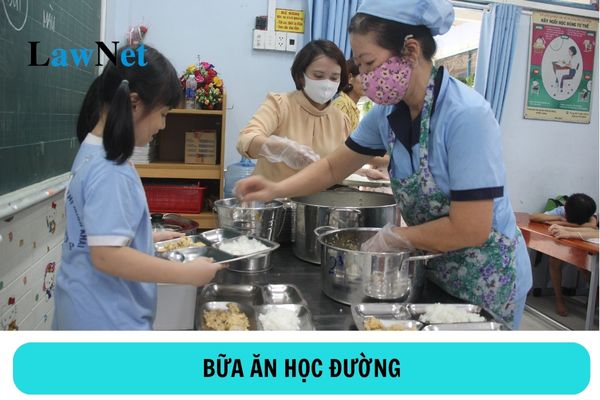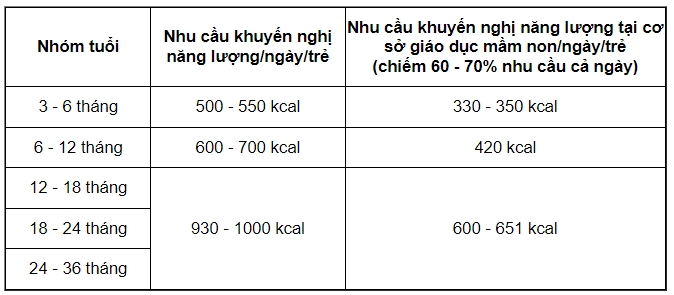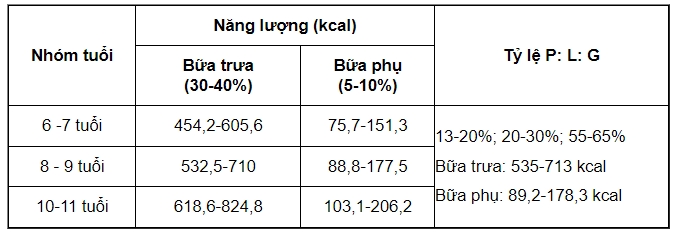What are meals at preschools and primary schools in Vietnam? What are principles for meals at schools in Vietnam?
What are meals at preschools and primary schools in Vietnam?
Based on subsection 1, Section 1, Part 1 of the Guidance on organizing school meals combined with physical activities for children and students at preschools and primary educational institutions issued together with Decision 2195/QD-BGDDT of 2022, a school meal is a meal prepared to provide energy and nutrients for students at the school.
School meals may include breakfast, lunch, afternoon snacks, and supplementary meals (snack time) during mid-morning or mid-afternoon. The number of school meals varies depending on the type of boarding and schooling levels.

What are meals at preschools and primary schools in Vietnam? What are principles for meals at schools in Vietnam? (Image from Internet)
What is the role of school meals in the health of primary school students and preschool children in Vietnam?
According to subsection 2, Section 1, Part 1 of the Guidance on organizing school meals combined with physical activities for children and students at preschool and primary educational institutions issued together with Decision 2195/QD-BGDDT of 2022, the role of school meals in the health of primary school students and preschool children is as follows:
- Provide energy and nutrients for students to meet the needs of study activities, physical development, and mental development according to their age group.
- Ensure food security for students in policy-beneficiary categories who receive free school meals to help children develop healthily and be strong enough to participate in learning activities.
- Establish scientific and healthy eating habits in students.
- Support the control of nutrition-related diseases, including malnutrition, micronutrient deficiencies, overweight, obesity, etc.
What are the general principles in organizing school meals in Vietnam?
According to Section 1, Part 2 of the Guidance on organizing school meals combined with physical activities for children and students at preschool and primary educational institutions issued together with Decision 2195/QD-BGDDT of 2022, the general principles for organizing school meals are as follows:
(1). Ensure adequate energy and necessary nutrients
- For preschool children (<36 months)
* Recommended energy consumption for preschool children

* Recommended percentage of energy-producing nutrients:
+ Protein supplies about 13% - 20% of the energy intake.
+ Lipids provide around 30% - 40% of the energy intake.
+ Carbohydrates supply about 47% - 50% of the energy intake.
- For preschool children (36 - 72 months)
* Recommended energy intake and eating policies for preschool children

* Recommended percentage of energy-producing nutrients:
+ Protein supplies about 13% - 20% of the energy intake.
+ Lipids provide around 25% - 35% of the energy intake.
+ Carbohydrates supply about 52% - 60% of the energy intake.
- For primary school students (ages 6 to 11)
* Recommended energy intake at school

* Recommended percentage of energy-producing nutrients:
+ Protein supplies about 13% - 20% of the energy intake.
+ Lipids provide around 20% - 30% of the energy intake.
+ Carbohydrates supply about 55% - 65% of the energy intake.
In addition to energy, protein, lipids, and carbohydrates, it is essential to ensure adequate intake of vital micronutrients such as calcium, iron, zinc, vitamins A, B, C, D, E, and fiber.
(2). Ensure the distribution ratio of energy for meals at school
The distribution of energy for meals for students at school should adhere to the general ratio for meals during the day according to each age group, as follows:
* Energy distribution for meals of preschool children (<36 months)
- The number of meals in the preschool educational institution: Two main meals and one supplementary meal.
+ Lunch supplies from 30% to 35% of the total daily energy.
+ Afternoon meal provides from 25% to 30% of the total daily energy.
+ Supplementary meal supplies about 5% to 10% of the total daily energy.
* Energy distribution for meals of preschool children (36 - 72 months)
- The number of meals for preschool children in the preschool educational institution: One main meal and one supplementary meal.
+ The main lunch supplies from 30% to 35% of the total daily energy.
+ The afternoon meal provides from 15% to 25% of the total daily energy.
*Note: In permissible conditions (regarding parental demand, human resources, and facilities...), the institution can organize breakfast for children. However, the organization must be agreed upon by the board of directors, the teachers' collective, and the parents. Breakfast should supply about 10% - 15% of the total daily energy needs.
* Energy distribution for school meals of primary school students
- The number of meals for primary school students at school: one main meal and one supplementary meal.
+ Lunch should meet 30-40% of the recommended daily energy requirement by age.
+ Supplementary meal should meet 5-10% of the daily energy requirement.
- For primary schools that organize school meals divided into 4 meals, the energy distribution for each meal is as follows:
+ Breakfast should meet 25-30% of the total daily energy.
+ Lunch should meet 30-40% of the total daily energy.
+ Supplementary meal should meet 5-10% of the daily energy.
+ Dinner should meet 25-30% of the total daily energy.
- For primary schools that do not organize school meals or organize meals without supplementary meals: It is necessary to ensure a minimum of 3 main meals per day and not allow students to skip breakfast before going to school.
(3). Ensure scientific, balanced, and reasonable meal planning
- School meal menus should ensure a variety of foods. The preparation includes stir-fry dishes, main dishes, soups, and desserts. It is recommended to have at least 10 different types of food, with a minimum of 5 out of 8 recommended food groups by the World Health Organization, including mandatory fat groups. These include groups: rich in protein (meat, fish, seafood, eggs, beans...), fats (cooking oil, fat), carbohydrates (rice, noodles, vermicelli...), vegetables, fruits, and milk.
- Menus should be feasible, reasonably prepared, ensuring nutrition and food safety, suitable for each educational institution's regulations and conditions.

